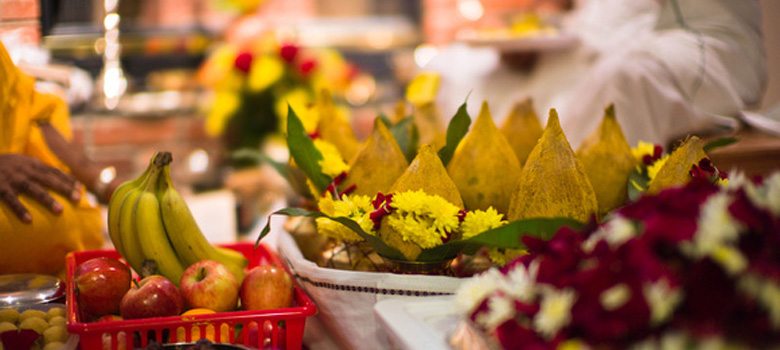Catering services in Bangalore
UPANAYANAM

Upanayanam is one of the important 16 Hindu samskaras. The samskaras are essentially rituals and are outward and visible signs of inward or spiritual grace. The hindus believe, the samskaras make a human being whole, meritorious and perfect. Upanayanam is also called holy thread ceremony. This is called the boy’s second or spiritual birth. The word means, bringing the boy near the guru. In ncient days, the boy started his gurukula vasa then. He is invested with the sacred thread-yagnopavitha and initiated with the Gayathri mantra. This initiation makes him dvija – twice born.
The initiation into Gayathri mantra is his second birth. The thread consists of three threads knitted together. He who wears this thread should have a triple control over his Mind, speech and body Thought, word and action. From, now on, the boy has a right to utter all sacred mantras. The Gayathri mantra itself does not talk of God – it only proclaims nature as supreme. Om bhur bhuvas suvah Tat savitur vareNyam Bhargo devasya dheemahi Dhiyo yo na prachOdayat.
ENGAGEMENT

The bride’s family brings turmeric, betel leaves, nuts and clothes for the groom. The bride’s brother then honours the groom by placing a flower garland around his neck. As a symbol of happiness, sugar candy is distributed to all guests. Then, an ‘Aarthi’ is performed, and a coconut is broken, a ritual believed to ward off evil eyes. On the “medai” or raised platform, both families sit opposite to each other and the “lagna patrika,” or marriage contract is written and read aloud by the ‘priest or sastrigal’. The document includes the names of both the families, the names of the bride and groom and the agreement that the marriage is to be conducted and it is signed by both bride’s and groom’s parents. After this, Thamboolams’ (platters of betel nuts, dry fruits, nuts, coconuts, turmeric and ‘kumkum’) and gifts are exchanged. The cone shaped “parupputhengai” is an important part of all these ceremonies.
SEEMENTHEM

During the seventh month of pregnancy a ceremony called Valakappu is performed. On this day new bangles are given to the pregnant woman. The ceremony is performed in two phases. Valakappu is that part of the ritual which is performed in the morning while Seenanthann is performed in the evenings. The expectant mother is given bangles by her mother (usually a pair each of gold and silver) and other guests (mainly green). Prayers are held and holy water is sprinkled on the expectant mother. This and sound of the bangles are believed to bring the child to a life Manthrams are intended to purify the foetus and to request Brahmavu, Agni, Ragadevi, Vishnu, Soman and Gangadevi to protect it, to make the delivery smooth and to make the son intelligent
GRUHAPRAVESAM

Griha Pravesh is a ceremony performed on the occasion of one’s first entry into a new house. Once the house is ready, the family moves in on an auspicious day that is determined by the astrological charts. Purity of panchang (almanac) and auspicious time (muhurat) must be considered during the griha pravesh. Three types of griha pravesh have been mentioned in our ancient scriptures Pooja Arrangement in Bangalore
Apoorva : First entry to newly constructed house on a newly selected land is called apoorva (new) griha pravesh.
Sapoorva: Entry into an already existing house after travelling abroad or migration elsewhere is called sapoorva griha pravesh.
Dwandwah: Entry into a house to after reconstruction or renovation subsequent to damage due to fire, flood or earthquake, is termed as dwandwah (old) griha pravesh
For apoorva griha pravesh, the exact auspicious time need to be adhered to. For sapoorva griha pravesh or dwandwah griha pravesh, the purity of the panchang should be given due consideration.
SASHTIABDHAPOORTHI

Shashti Abda Poorthi (Sanskrit meaning: Sashti == 60, Abda == years, Poorthi == completion) is also known as ‘Sashti Poorthi’. It is a Hindu ceremony that is celebrated to commemorate the 60th birthday of a person. From the Western perspective, it is close to the sliver-wedding anniversary. As per the Hindu culture, the age sixty is of great significance because it is considered as a turning point in a man’s life for at this age one has usually fulfilled his commitments to family and home and so he can turn his mind to spirituality. We can say that, the period before he reached sixty is defined by materialistic pursuits and thereafter it is to be defined by his strive towards spiritualism.
- On the janma Nakshathram day of 60th year beginning (59 over) Ugra Radha Santhi is done.
- When Sixty years over and 61 year commences (Janma Nakshathram day) Sasti Apthapoorthy Santhi is done. (Incidently because Hindu 60 year cycle, the birth year (name) repeats in the Prabha - Akshya scale)
- When 69 years over and 70th year commences (Janma Nakshathra day) Bhima Ratha Santhi is done.
- On the 77 years 7 months and 7 days day, Vijaya Ratha Santhi is done.
- On the end of 80 years and 8 months or after seeing 1000 full moon days Sathabishekam is done (Many do at the end end of 80 years).
(1000 X 29.53)/ 365.25 = 80.8487337440 years (80 years and 10 months).
{ Approximately, (1000 X 30)/ 360 = 83.33333 years (83 years and 4 months)} - On the end of 100 years and beginning of 101 year Kanakabishekam is done.
- Rudra Ekaadasini and other procedures for Saivites are similar for all occasions. Mangalaya Dharanam is only for Shasti Apthapoorthy Santhi.
